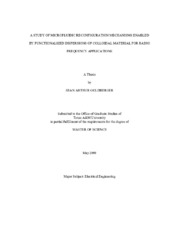| dc.contributor.advisor | Huff, Gregory H. | |
| dc.creator | Goldberger, Sean A. | |
| dc.date.accessioned | 2010-07-15T00:12:34Z | |
| dc.date.accessioned | 2010-07-23T21:44:00Z | |
| dc.date.available | 2010-07-15T00:12:34Z | |
| dc.date.available | 2010-07-23T21:44:00Z | |
| dc.date.created | 2009-05 | |
| dc.date.issued | 2010-07-14 | |
| dc.date.submitted | May 2009 | |
| dc.identifier.uri | https://hdl.handle.net/1969.1/ETD-TAMU-2009-05-535 | |
| dc.description.abstract | Communication and reconnaissance systems are requiring increasing flexibility concerning functionality and efficiency for multiband and broadband frequency applications. Circuit-based reconfiguration mechanisms continue to promote radio frequency (RF) application flexibility; however, increasing limitations have resulted in hindering performance. Therefore, the implementation of a "wireless" reconfiguration mechanism provides the required agility and amicability for microwave circuits and antennas without local overhead. The wireless reconfiguration mechanism in this thesis integrates dynamic, fluidic-based material systems to achieve electromagnetic agility and reduce the need for "wired" reconfiguration technologies. The dynamic material system component has become known as electromagnetically functionalized colloidal dispersions (EFCDs). In a microfluidic reconfiguration system, they provide electromagnetic agility by altering the colloidal volume fraction of EFCDs - their name highlights the special considerations we give to material systems in applied electromagnetics towards lowering loss and reducing system complexity. Utilizing EFCDs at the RF device-level produced the first circuit-type integration of this reconfiguration system; this is identified as the coaxial stub microfluidic impedance transformer (COSMIX). The COSMIX is a small hollowed segment of transmission line with results showing a full reactive loop (capacitive to inductive tuning) around the Smith chart over a 1.2 GHz bandwidth. A second microfluidic application demonstrates a novel antenna reconfiguration mechanism for a 3 GHz microstrip patch antenna. Results showed a 300 MHz downward frequency shift by dielectric colloidal dispersions. Magnetic material produced a 40 MHz frequency shift. The final application demonstrates the dynamically altering microfluidic system for a 3 GHz 1x2 array of linearly polarized microstrip patch antennas. The parallel microfluidic capillaries were imbedded in polydimethylsiloxane (PDMS). Both E- and H-plane designs showed a 250 MHz frequency shift by dielectric colloidal dispersions. Results showed a strong correlation between decreasing electrical length of the elements and an increase of the volume fraction, causing frequency to decrease and mutual coupling to increase. Measured, modeled, and analytical results for impedance, voltage standing wave ratio (VSWR), and radiation behavior (where applicable) are provided. | en |
| dc.format.mimetype | application/pdf | |
| dc.language.iso | eng | |
| dc.subject | Array | en |
| dc.subject | Barium Strontium Titanate | en |
| dc.subject | Coax | en |
| dc.subject | Colloidal | en |
| dc.subject | Dispersion | en |
| dc.subject | EFCDs | en |
| dc.subject | Frequency Reconfiguration | en |
| dc.subject | Impedance Transformer | en |
| dc.subject | Magnetodielectric | en |
| dc.subject | Microfluidic | en |
| dc.subject | Microstrip Patch Antenna | en |
| dc.subject | Non-aqueous | en |
| dc.subject | PDMS | en |
| dc.subject | Perturbation | en |
| dc.subject | Reconfigurable | en |
| dc.subject | Reconfigurable Antenna | en |
| dc.subject | Reconfiguration Mechanism | en |
| dc.subject | RF | en |
| dc.subject | Radio Frequency | en |
| dc.subject | Strontium Hexaferrite | en |
| dc.subject | Stub | en |
| dc.subject | Surfactant | en |
| dc.subject | Transmission Line | en |
| dc.subject | Vascular | en |
| dc.title | A Study of Microfluidic Reconfiguration Mechanisms Enabled by Functionalized Dispersions of Colloidal Material for Radio Frequency Applications | en |
| dc.type | Book | en |
| dc.type | Thesis | en |
| thesis.degree.department | Electrical and Computer Engineering | en |
| thesis.degree.discipline | Electrical Engineering | en |
| thesis.degree.grantor | Texas A&M University | en |
| thesis.degree.name | Master of Science | en |
| thesis.degree.level | Masters | en |
| dc.contributor.committeeMember | Nevels, Robert D. | |
| dc.contributor.committeeMember | Chang, Kia | |
| dc.contributor.committeeMember | Orville, Richard | |
| dc.type.genre | Electronic Thesis | en |
| dc.type.material | text | en |


